
Rubus parviflorus, commonly called thimbleberry, is a species of Rubus native to northern temperate regions of North America. It bears edible red fruit similar in appearance to a raspberry, but shorter, almost hemispherical. Because the fruit does not hold together well, it has not been commercially developed for the retail berry market, but is cultivated for landscapes. The plant has large fuzzy leaves and no thorns.

Lepechinia fragrans is a flowering herbaceous shrub known by the common names island pitchersage and fragrant pitchersage. It is a member of the Lamiaceae, or mint family, but like other Lepechinia, the flowers are borne in racemes instead of in mintlike whorls.

Lycium andersonii is a species of flowering plant in the nightshade family, Solanaceae. Its common names include water-jacket, redberry desert-thorn, Anderson thornbush, Anderson's desert thorn, Anderson boxthorn, Anderson lycium, Anderson wolfberry, and squawberry.

Astragalus nuttallii is a species of milkvetch known by the common name Nuttall's milkvetch. It is native to California and Baja California, where it grows in the sandy soils of coastal habitat. This is a perennial herb forming thick, tangled clumps of hairy to hairless stems up to a meter in length. The abundant leaves are up to 17 centimeters in length and made up of many oval-shaped leaflets. The inflorescence is a large, dense body of up to 125 flowers, each around 1 to 1.5 centimeters long. The flowers are dull cream-colored and sometimes purple-tinted. The fruit is an inflated legume pod up to 6 centimeters long which dries to a papery texture and contains many seeds in its single chamber. One variety of this species, the ocean bluff milkvetch is endemic to the Central Coast of California.

Minuartia nuttallii is a species of flowering plant in the family Caryophyllaceae known by the common names Nuttall's sandwort and brittle sandwort.
Tetradymia argyraea is a species of flowering plant in the aster family known by the common names striped cottonthorn and striped horsebrush. It is native to the desert mountains of the southwestern United States, particularly of California, Nevada, and Arizona, where it grows in desert woodland habitat. It is a woolly, spiny shrub growing one half to nearly two meters in maximum height. The erect stems are white-woolly except for bare stripes at intervals. The leaves are linear in shape and harden as they age, becoming spiny. The larger leaves are woolly and there are clusters of smaller, threadlike leaves which may be hairless. The inflorescence bears two to five flower heads which are each enveloped in five thick phyllaries coated in white woolly hairs. Each head contains five pale yellow flowers each around a centimeter long. Flowers are produced in summer, as late as September. The fruit is an achene a few millimeters long tipped with a pappus of bristles.

Tetradymia argyraea is a species of flowering plant in the aster family known by the common names spineless horsebrush and gray horsebrush. It is native to western North America from British Columbia to California to New Mexico, where it grows in sagebrush, woodlands, forest, scrubby open plains, and other habitat. It is a bushy shrub growing to 60 to 80 centimeters in maximum height with multibranched woody or semi-woody stems that grow from taproots. It is coated in woolly fibers with hairless strips at intervals along the branches. It has no spines. The lance-shaped leaves are no more than 4 centimeters long and woolly or silver-haired in texture. Longer-lived leaves are alternately arranged along the stem and smaller, shorter-lived leaves occur in clusters near the axils of the primary leaves. The inflorescence bears usually three to six flower heads which are each enveloped in four thick phyllaries coated in white woolly hairs. Each head contains four tubular flowers in shades of pale to bright yellow, each measuring up to 1.5 centimeters long. Flowers are produced in summer. The fruit is an achene which may be up to 1.5 centimeters long including its long pappus of bristles.
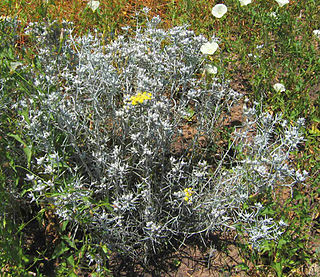
Tetradymia comosa is a species of flowering plant in the aster family, known by the common name hairy horsebrush.
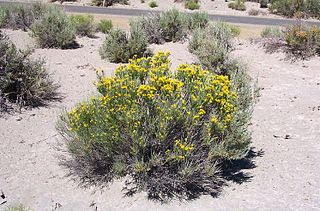
Tetradymia glabrata is a species of flowering plant in the aster family known by the common name littleleaf horsebrush. It is native to the western United States, especially the Great Basin and Mojave Desert. Its habitat includes sagebrush, woodlands, and scrub. It is an erect, bushy shrub growing to a maximum height over one meter, its stems coated unevenly in white woolly fibers with many bare strips. The narrow, pointed leaves are usually no more than a centimeter long and most occur in clusters along the branches. The inflorescence bears up to seven flower heads which are each enveloped in four woolly phyllaries. Each head contains four yellow cream flowers each around a centimeter long. The fruit is a hairy, ribbed achene with a pappus of bristles.

Tetradymia spinosa is a species of flowering plant in the aster family known by the common name shortspine horsebrush. It is native to the western United States, especially the basins and plateaus west of the Rocky Mountains. It grows in sagebrush, woodlands, and scrub habitat, often among shadscale in alkaline areas such as playas. It is a bushy shrub with many branches coated in woolly white fibers and growing to a maximum height around a meter. The leaves are narrow, curving, and hooklike, hardening into sharp spines up to 2.5 centimeters long. The inflorescence bears one or two flower heads which are each enveloped in four to six woolly phyllaries. Each head contains up to 8 tubular yellow flowers up to a centimeter long. The fruit is a densely hairy achene which may be nearly 2 centimeters long, including its pappus of long bristles.
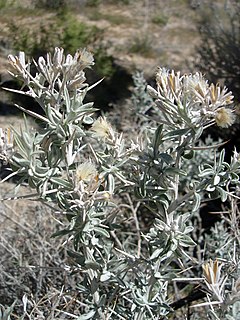
Tetradymia stenolepis is a species of flowering plant in the aster family known by the common name Mojave cottonthorn. It is native to the deserts around the intersection of Arizona, Nevada, and eastern California, where it grows in woodland and scrub habitat on sandy and gravelly substrates. It is a bushy shrub with many branches coated in woolly white fibers and growing to a maximum height just over a meter. The narrow leaves are 2 or 3 centimeters long and harden into straight, sharp spines. Clusters of woolly leaves grow near the spines. The inflorescence bears up to 7 flower heads which are each enveloped in four or five woolly phyllaries. Each head contains up to four or five tubular yellow flowers each around a centimeter long. The fruit is a hairy achene which may be nearly 2 centimeters long, including its pappus of long bristles.
Tetradymia tetrameres is a species of flowering plant in the aster family known by the common name fourpart horsebrush and dune horsebrush. It is native to the Great Basin, where it occurs in western Nevada and just over the border in Mono County, California. It is a plant of dry scrub and sand dunes. It is a bushy, woolly shrub with many erect, spineless branches. It is the largest of the horsebrushes, growing up to two meters in height. The soft, woolly leaves are narrow and threadlike, growing up to 4 centimeters long. Shorter leaves occur in clusters around the primary leaves. The inflorescence bears 4 to 6 flower heads which are each enveloped in four or five woolly phyllaries. Each head contains up to four or five light yellow flowers each around a centimeter long. The fruit is a hairy achene which may be up to a centimeter long, including its pappus of long bristles.

Toxicoscordion paniculatum is a species of flowering plant known by the common names foothill deathcamas and sand-corn. It is widely distributed across much of the western United States, especially in the mountains and deserts of the Great Basin region west of the Rocky Mountains. It grows in many types of habitat, including sagebrush plateau, grasslands, forests, and woodlands, etc.
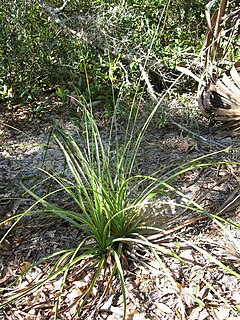
Nolina brittoniana is a rare species of flowering plant in the asparagus family known by the common name Britton's beargrass. It is endemic to Florida, where there are 72 known populations, only a few of which are large enough to be considered viable. It is federally listed as an endangered species of the United States.

Nolina microcarpa is a species of flowering plant in the asparagus family known by the common names sacahuista and palmilla. Like other species of Nolina, it may be called beargrass. It is native to northern Mexico and the southwestern United States in Arizona and New Mexico. It does occur in the southwestern corner of Utah, where it has a limited distribution on Navajo Sandstone, but reports of it occurring in Texas may be in error.

Lyonia lucida is a species of flowering plant in the family Ericaceae known by the common names fetterbush lyonia, hurrahbush, and staggerbush. Other plants may also be called fetterbush. This broadleaved evergreen plant grows on the coastal plain of the southeastern United States from Virginia to Florida to Louisiana. It also occurs in Cuba.

Dodecatheon austrofrigidum is a species of flowering plant in the primrose family known by the common names frigid shooting star and tundra shooting star. It is native to Washington and Oregon in the United States, where it grows in the coastal mountain ranges, including those on the Olympic Peninsula.

Eriogonum visheri is a species of wild buckwheat known by the common names Dakota wild buckwheat and Visher's buckwheat. It is native to the Great Plains in the United States, where it is known from North Dakota, South Dakota, and Montana.
Astragalus anisus is a species of flowering plant in the legume family known by the common name Gunnison milkvetch. It is endemic to Colorado in the United States, where it is limited to the Gunnison Basin of Gunnison and Saguache Counties.
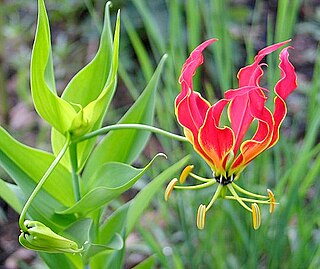
Gloriosa superba is a species of flowering plant in the family Colchicaceae. Common names include flame lily, climbing lily, creeping lily, glory lily, gloriosa lily, tiger claw, and fire lily.


















